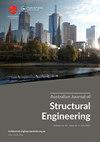混凝土板与钢组合梁结合螺栓剪切连接件的互锁性能
IF 1.3
Q4 ENGINEERING, CIVIL
Australian Journal of Structural Engineering
Pub Date : 2021-07-03
DOI:10.1080/13287982.2021.1957553
引用次数: 0
摘要
混凝土和钢在组合梁中的复杂性已经在许多研究中得到了解决。然而,预制混凝土板在钢-混凝土组合结构中的应用被认为是一种新技术,因此许多影响其性能的因素需要进行研究。介绍了混凝土预制板间舌槽联锁接缝的应用,引起了人们的兴趣。为此,采用有限元分析方法对普通预制板与互锁舌槽预制板在组合结构中的性能进行了比较。两者都设计为使用螺栓剪切连接器具有完全的复合作用。在本研究中,共建立了五个模型,包括一个控制模型,以研究指定组合梁的受弯性能。模型与实验结果进行了验证,结果吻合较好。参数研究进行了调查螺栓尺寸和高度对梁的弯曲行为的影响。研究表明,大直径锚杆板间联锁节点的存在可以有效地提高复合体系的刚度。本文章由计算机程序翻译,如有差异,请以英文原文为准。
Behaviour of interlocking concrete slab and steel composite beam incorporated bolt shear connector
ABSTRACT The complexity of concrete and steel in composite beam has been addressed in many studies previously. However, the use of precast concrete slab in steel–concrete composite construction is considered as new, hence many factors that affect its behaviour need to be investigated. It becomes interesting when the application of interlocking tongue and groove joints between precast concrete slabs is introduced. For this purpose, a performance comparison between normal precast slab and interlocking tongue and groove precast slab in composite construction is conducted using finite element analysis. Both are designed to have full composite action using bolted shear connector. In this research, a total of five models including a control model were developed to study the flexural behaviour of designated composite beam. The model has been verified against experimental results, which showed a good agreement . Parametric studies were performed to investigate the effects of bolt size and height on flexural behaviour of the beam. The present study demonstrated that the presence of interlocking joints between slabs with larger diameter bolt can efficiently improve the stiffness of the composite system.
求助全文
通过发布文献求助,成功后即可免费获取论文全文。
去求助
来源期刊

Australian Journal of Structural Engineering
ENGINEERING, CIVIL-
CiteScore
2.50
自引率
0.00%
发文量
31
期刊介绍:
The Australian Journal of Structural Engineering (AJSE) is published under the auspices of the Structural College Board of Engineers Australia. It fulfils part of the Board''s mission for Continuing Professional Development. The journal also offers a means for exchange and interaction of scientific and professional issues and technical developments. The journal is open to members and non-members of Engineers Australia. Original papers on research and development (Technical Papers) and professional matters and achievements (Professional Papers) in all areas relevant to the science, art and practice of structural engineering are considered for possible publication. All papers and technical notes are peer-reviewed. The fundamental criterion for acceptance for publication is the intellectual and professional value of the contribution. Occasionally, papers previously published in essentially the same form elsewhere may be considered for publication. In this case acknowledgement to prior publication must be included in a footnote on page one of the manuscript. These papers are peer-reviewed as new submissions. The length of acceptable contributions typically should not exceed 4,000 to 5,000 word equivalents. Longer manuscripts may be considered at the discretion of the Editor. Technical Notes typically should not exceed about 1,000 word equivalents. Discussions on a Paper or Note published in the AJSE are welcomed. Discussions must address significant matters related to the content of a Paper or Technical Note and may include supplementary and critical comments and questions regarding content.
 求助内容:
求助内容: 应助结果提醒方式:
应助结果提醒方式:


